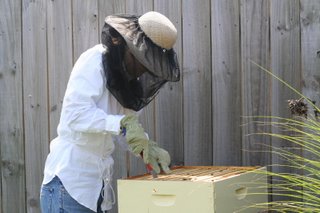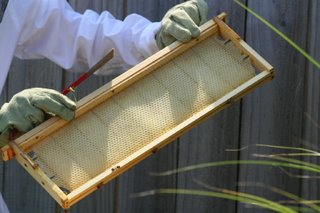The Beeyard in October and November
In June, our local beekeeper's association reported that Kentucky was experiencing a "fair to mediocre honey crop" this season. Much later, a state apiarist revised his assessment and called it a "terrible" honey crop for many beekeeper's in the state. Ohio and Tennessee have reported low yields as well. When Erin went to pick up bee meds, the apiarist said that in all his hives, there wasn't a honey crop worth even mentioning. All this time we kept thinking that beekeepers weren't finding honey in excess. It never occurred to us that our hives might be in danger of starvation!
In October's newsletter, the state apiarist warned beekeepers to check food stores and mentioned many beekeepers had been feeding their bees supplemental food since August. August?! It gave us kind of a sick feeling in the pits of our stomachs. At that point, we were still seeing lots of bees flying around--they still looked like strong colonies. There were times--especially in the mornings--we'd see bee after bee flying pollen into the hives, and we took this to be a very good sign, we felt assured that they were preparing for winter. We continued to check hives in a way that was minimally invasive--there were lots of bees and they looked very active on the frames. As colder weather began creeping in, we added the bottom boards and entrance reducers. We even put on the feeders and gave each hive some sugar syrup. All seemed to be going well....
But when we finally had a sunny day in October with low wind, I went out for a hive check, just to take a close look at food stores and make certain all was well. I looked at the frames in the top brood boxes of each hive, and when I didn't see any food or even brood to speak of, I moved into the second boxes--no food there either. I checked the frames of the bottoms--nothing. In both hives, I found empty frames and only sparse signs of brood. Hive 1 had a larger population, Hive 2 looked considerably small. I was shocked. I couldn't tell if the queens and a good portion of bees had recently flown off to find better food sources, or if the population had simply dwindled....I remembered reading that queens will stop laying eggs if pollen and resources become scarce. For a brief time I wondered if I should order more queens if ours had indeed left to find food somewhere else. I called Walter T. Kelley Bee Supply Company and found it was too late to order queens in our state. Erin and I felt it was too late for a reason--the companies don't sell bees now because their chances of doing well heading into winter is very slim (for so many reasons!). If we wanted to force the issue, we could order from Big Island, Hawaii. Even if we were sure about the status of our queens, doing such a thing felt incredibly foolish--and expensive. For the chances of success and cost, I think no matter what is happening in our hives at this late date, the best we can do is feed the bees through winter, and we'll see if we have survivors by spring. If we wanted to then order more bees or queens, the cost is more reasonable and they have a much better chance of succeeding in the warmth and natural colony-building time of the season.
So, what we know is that we have bees who need food. We found a sugar syrup recipe for winter, which is a lot thicker. For our big pot, we've been making 6 cups very warm water blended with 12 cups sugar till it is dissolved and makes a very thinck syrup. We began this formula the last 1-2 weeks in October, and there have been days mild enough for them to process the syrup and fly about. More recently on sunny days, they've foraged the water I leave out for them. However, the supplemental feeding has been difficult as well since I've found bees drowning in the sugar syrup--how did they get IN it?!!--and I've had to fish them out with a spoon several times. Erin placed wood pieces in the trays, and we've closed the covers with 2 logs each on the tops. This seems to help tremendously in HIVE 1, but in Hive 2 bees still managed to perish--so much so that I'm not even certain we have any bees left in that hive!! The weather has been too rainy to check.
I read an article in the November newsletter, originally published in Bee Culture magazine....an apiarist described having 80 hives and 40 hives don't have 5 pounds of honey between them! He wrote that we had a late season frost which severely damaged early nectar and pollen sources. The heavy spring rains began and washed a nectar crop away one day at a time. Next, we experienced blazing heat. The honey crop came and went and either the plants weren't able to produce nectar and pollen in the intervals, or our bees weren't able to harvest the crop. He also mentions having to wear full gear at all times when working the bees this season because they were testy and more aggressive than usual, probably trying to protect what little stores of honey they had! We certainly experienced the same type of behavior.
As new beekeepers, we feel less discouraged knowing that even the more experienced apiarists have had a tough season as well. In looking back, we can say we've sure learned a whole lot. We've built and painted the hives and assembled all the frames....we've learned about our gear and have even become better at keeping the smoker lit....we've conducted a range of hive checks, from the most invasive to the least....we've seen eggs and brood and bees emerging for the first time....we've learned to weather stings....we've observed bee behavior--drinking water, carrying pollen, foraging on the plants in our yard with other species, flying through water spray on a hot day, hanging out on the front porch of their hives....we've taken some beautiful photographs throughout the season that we treasure....and we've experienced a whole lot of harmony--humans, dogs, bees, and all sorts of creatures moving through the beeyard together peacefully. On beautiful days, we often felt a heightened sense of wonderment, which was a blessing in itself. Clearly we have a lot more to learn, and we have several bee books that will make good winter reading. No matter the state of the hives in spring, I believe we will be ready for a fresh start!
























